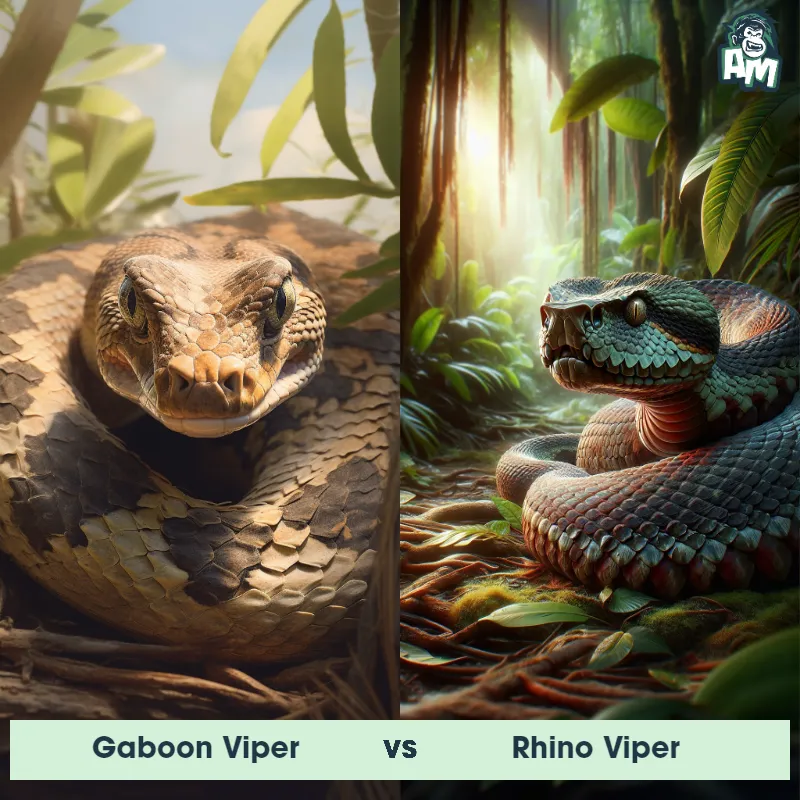The Rhino Viper
The Rhino Viper, also known as Bitis nasicornis, is a venomous snake found in the rainforests and wooded areas of West and Central Africa. It is named after the horn-like structures on its snout, giving it a rhinoceros-like appearance. This viper is known for its vibrant and striking coloration, which varies between individuals but usually includes a combination of shades of green, brown, and yellow. It has a robust body, broad triangular head, and muscular build, with males typically growing larger than females. The Rhino Viper possesses long fangs and venom glands, making it a highly dangerous and deadly predator in its environment.

| Rhino Viper | |
|---|---|
| Size | 1.2 to 2 meters (3.9 to 6.6 feet) |
| Weight | Varies |
| Speed | 0mph (0km/h) |
| Key Strength | Venomous bite |
| Biggest Weakness | Slow movement |
| Scientific Name | Bitis nasicornis |
| Family | Viperidae |
| Habitat | Rainforests |
| Geography | West and Central Africa |
| Diet | Carnivorous |
| Lifespan | 10 years - 15 years |

The Rhino Viper
The Rhino Viper, also known as Bitis nasicornis, is a venomous snake found in the rainforests and wooded areas of West and Central Africa. It is named after the horn-like structures on its snout, giving it a rhinoceros-like appearance. This viper is known for its vibrant and striking coloration, which varies between individuals but usually includes a combination of shades of green, brown, and yellow. It has a robust body, broad triangular head, and muscular build, with males typically growing larger than females. The Rhino Viper possesses long fangs and venom glands, making it a highly dangerous and deadly predator in its environment.
Fun Fact: One intriguing fact about the Rhino Viper is that it has a specialized heat-sensing organ called "pit organs" located between its eyes and nostrils. These organs allow the snake to detect the body heat of its warm-blooded prey, such as small mammals and birds, even in complete darkness.
| Rhino Viper | |
|---|---|
| Size | 1.2 to 2 meters (3.9 to 6.6 feet) |
| Weight | Varies |
| Speed | 0mph (0km/h) |
| Key Strength | Venomous bite |
| Biggest Weakness | Slow movement |
| Scientific Name | Bitis nasicornis |
| Family | Viperidae |
| Habitat | Rainforests |
| Geography | West and Central Africa |
| Diet | Carnivorous |
| Lifespan | 10 years - 15 years |
Rhino Viper Matchups
We use AI to simulate matchups between the Rhino Viper and other animals. Our simulation considers size, strength, and natural predatory behaviors to determine the most likely outcome.

Can't find the Matchup you want?
Create Your Own MatchupRhino Viper: Diet, Predators, Aggression, and Defensive Behaviors
What do Rhino Vipers eat?
Rhino Vipers primarily feed on small mammals, birds, and other reptiles. They are ambush predators and rely on their camouflage and stealth to capture their prey. Their diet can also include frogs and rodents.
Do Rhino Vipers have any predators?
As adults, Rhino Vipers do not have many natural predators due to their venomous nature and intimidating appearance. However, young Rhino Vipers may be preyed upon by larger snakes, predatory birds, and mammals.
Are Rhino Vipers aggressive?
Rhino Vipers are known to be relatively calm and non-aggressive snakes. They generally prefer to avoid confrontation and will only strike when threatened or provoked. However, they should still be treated with caution due to their venomous bite.
Do Rhino Vipers fight?
Rhino Vipers may engage in combat with other members of their own species, especially during the mating season or when competing for territory. These "wrestling matches" involve entwining themselves and pushing against each other to assert dominance.
How do Rhino Vipers defend themselves?
Rhino Vipers have several defense mechanisms to protect themselves from potential threats. Their primary defense is their venomous bite, which can incapacitate or even kill their enemies. They also rely on their camouflage to blend in with their surroundings and avoid detection.
What is the biggest weakness of a Rhino Viper in a fight?
Despite their potent venom and defensive abilities, the biggest weakness of a Rhino Viper in a fight is their relatively slow speed and agility. They are ambush predators and do not have the speed or endurance to engage in prolonged physical confrontations.
Fun Fact: Another fascinating fact about the Rhino Viper is its ability to manipulate its coloration. It possesses specialized cells called chromatophores that change the distribution and intensity of pigments, allowing it to blend in with its surroundings and remain concealed from potential threats or unsuspecting prey.
Fun Fact: The venom of the Rhino Viper is highly potent and contains a mix of neurotoxins and hemotoxins. It is one of the fastest-acting snake venoms, causing severe tissue damage and potentially fatal consequences. Fortunately, despite its venomous nature, the Rhino Viper is not a particularly aggressive snake and usually relies on its camouflage and warning displays, such as hissing and inflating its body, to avoid confrontation before resorting to biting as a last defense mechanism.











